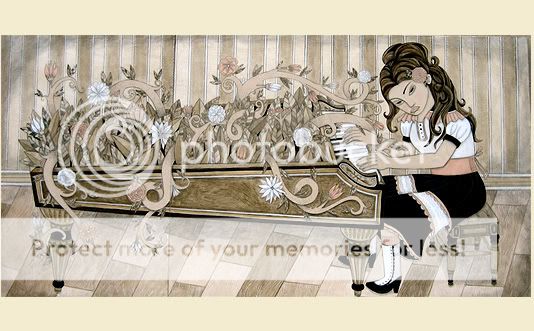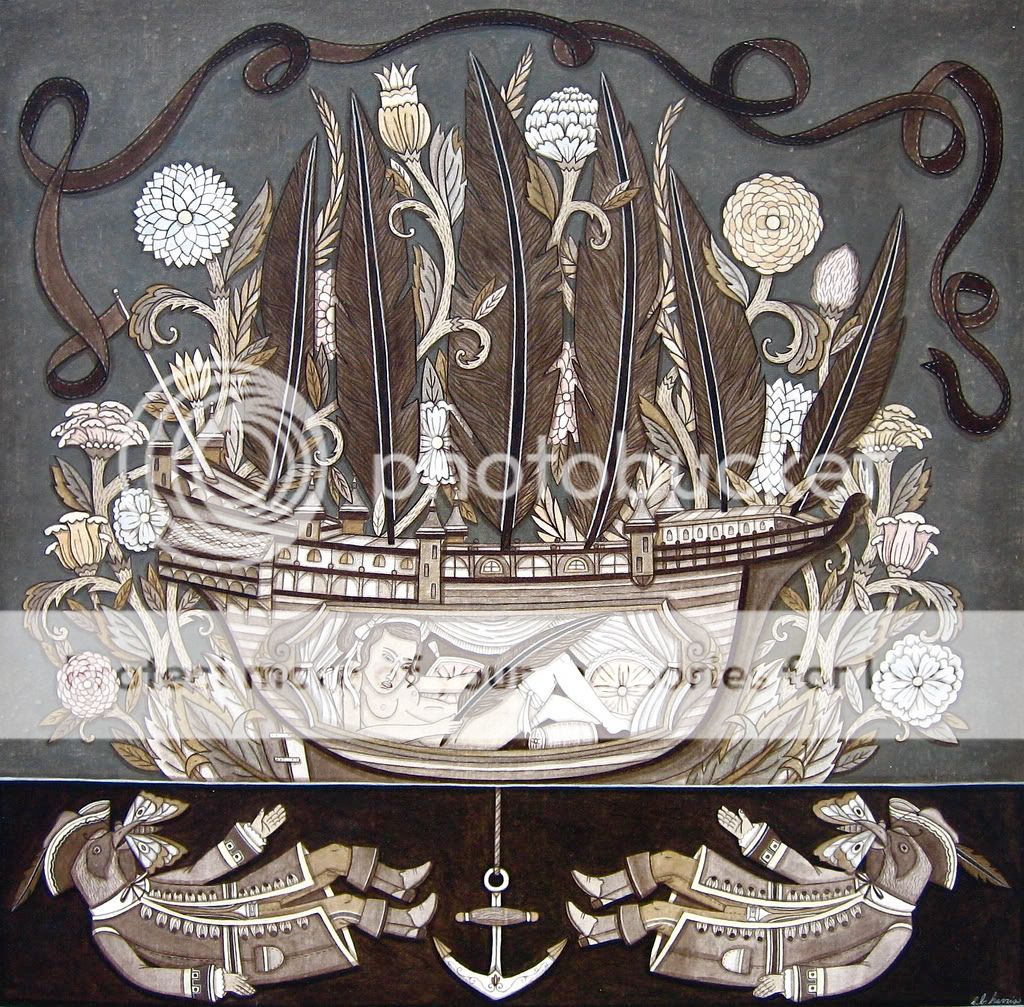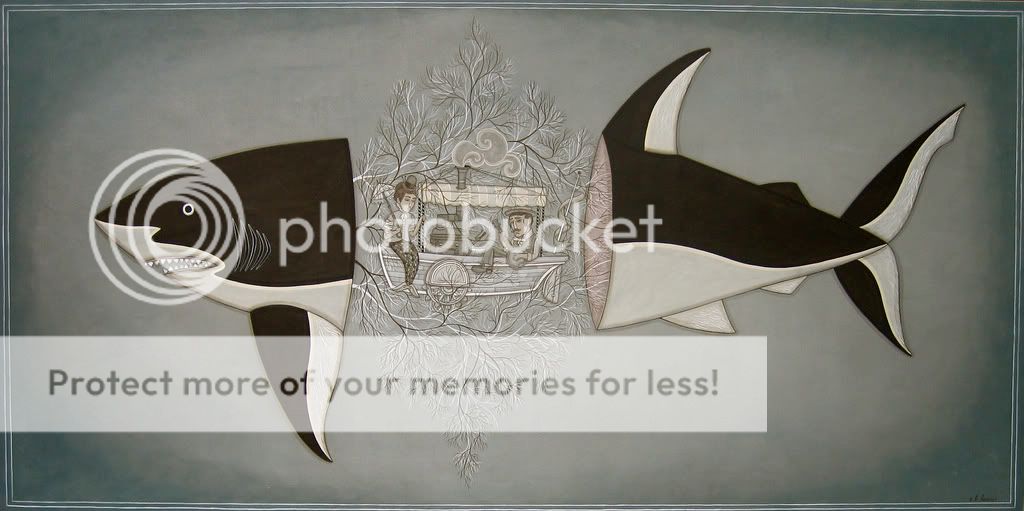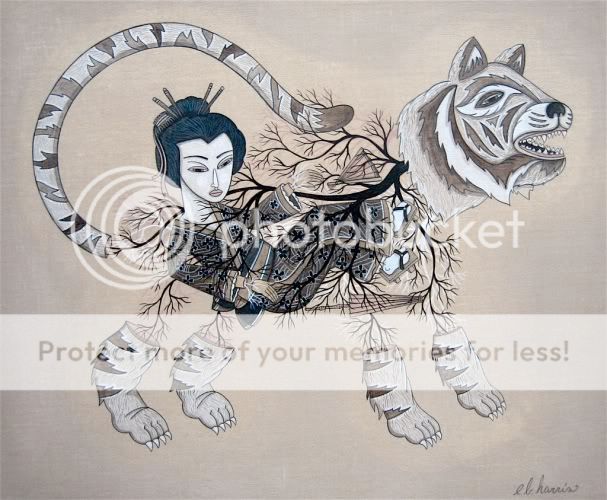
These images make me want to tell you a story. This is a true story. I live in a small town, and in my grandmother's generation, there was a piano teacher, we'll call her Audrey. Audrey was a beautiful woman, with thick, red hair and pale skin, demure but talented. She was especially good with the children, and so she was the favorite piano teacher in town, and therefore--in a town this size-- the only one. She was married to Charles, a handsome and very well-behaved young man. They lived in a little pink house which had a much smaller, but just as pink, replica of itself beside it. That was Miss Audrey's piano studio. I swear to you, this is true.
And then Charles died.
And Miss Audrey, who could not let go of her beloved husband, allowed him to be cleaned, dressed, and placed gently and respectfully into his coffin and brought to her studio. She instructed the men to place the coffin on top of the piano for the wake and viewing. All evening, people came and went, bringing their respects, their shared sorrow, and food.
And then the wake was over. But she would not allow the men to take the coffin back with them. She was very calm, and appeared to be completely lucid, and so they did not know what to do, how to respond to such a thing. Hysterics, they could handle, but this?
So they left.
And, after a few days, life in our little town moved on. She began again with her piano lessons. Children came and went, but though most of them were seemingly deaf, they had a very well-developed sense of smell, and when they returned home, they complained. And people began to realize what the men, in their confused shame, had kept silent about: Miss Audrey still had her husband, resting on top of her baby grand piano.

Finally, men from the city came. The mothers had gone to the mayor, a very well-liked man who had been mayor for as long as they could remember (and whose son has been mayor has long as anyone can remember), hysterical. And as I said before, the men in town knew how to deal with hysterics. They went and explained, carefully and quietly, to Miss Audrey about the issues of health and sanitation of keeping a dead body around, and then they gave her a tranquilizer despite her being quite tranquil, and they removed the coffin and put it in the ground.


"Feathers for her Ladyship"
Evan B. Harris seems to favor nautical themes, and people caught in cramped and hidden spaces that he unveils for the viewer.

"Dascyllus"
On his page, it says:
Born among the briars & brambles in backwoods of Medford, Oregon, Evan Benjamin Harris grew up with little knowledge of the bourgeois big city fine arts. So, he dove into the recesses of his own imagination and embraced the fables and folklore that fascinated him. With little to do but draw, he did exactly that. Now older, things haven’t changed much. The stories he created as a child are still present in his paintings. With diligence and hard work, Evan’s crude stick figures became the more clearly defined images you see today. With no formal art training, he creates on his own terms.
Broken boards, oil and acrylic paints, charcoal pastels, plastic resign, and melted waxes are among the mediums Evan uses. Then they are beaten, brushed, sanded, polished, and hung.
Most would cringe at the idea of scratching or sanding something they spent hours upon hours painting, but that’s Evan’s favorite part- creating the appearance that this wasn’t made in the 21st century, maybe in the 20th. So, behind every scratch and claw mark, there is a story to tell."

"Falcon or Fall"

"Barnacle and Butterflies"
The hair and the water in the painting above are just incredible to me.
Here he is painting the walls of the Ace Hotel, in Portland, Oregon:

In an interview with Victoria Everman, he was asked if he'd always lived in Oregon, and what influence living there has had on his art, and he said:
"I have lived outside of Oregon; after high school, I lived in Reno, NV. Then Hawaii, where I began to experiment with watercolors. The sunny climate and vivid colors that naturally show up there influenced my subject matter and palette heavily. It wasn’t until after Hawaii, when I returned to the Northwest (Seattle and then Portland) that I really found myself in an environment that suited me and my art. It was a return to what I grew up around, the mountains, the coast, the city… I love the old architecture. I guess I just feel the most inspired in Oregon."
They also talked a bit about his methods:
"After working with a variety of materials; such as charcoal, melted wax, and wood; which medium is your favorite to create with and why?"
Evan: "Acrylic paint is about the only thing I use now. There’s a lot of diversity to what you can do with it. I like to use them as a wash, like a watercolor. By diluting the paint, I can build up colors in layers. This gives me more freedom of shades and richness in a limited color palette."

He's done a whole series of works with an artist named Amy Ruppel, with whom he now shares a studio, which have a different, enchanting--ethereal, even--tone. These are acrylics, oils, and wax on board:

"Dawn"

"Hare of the North"

"Twilight"

"Winter Growth"

"Geisha and the Tiger"
He also has a series of of animals with people as their "innards." Is this mythological anthropomorphism in its own bizarre form? Many times in mythologies or legends or fairy tales, a person will be described as having the spirit of a tiger, say, or as moving like a panther. A boy might become a man by discovering his "spirit animal." But here, she is tangled up in the reaching, escaping mess of the veins of the animal in a rather non-spiritual-seeming way.

If I could ask him one question, it would be the stories behind these. Note that the lady tangled in the elephant holds a heart-lock in one hand.
Besides the webpage listed above, he has a Flickr page here, and an etsy page where you can buy prints here.
Enjoy!













I love the murals, I love the acrylics and i love your love crazy story :)
ReplyDeleteYou are always adding little something more interesting but this true story will be impossible to forget ever:) Beautiful post!
ReplyDeleteThis post is a trip, dear Zoe... you've made my day!
ReplyDelete